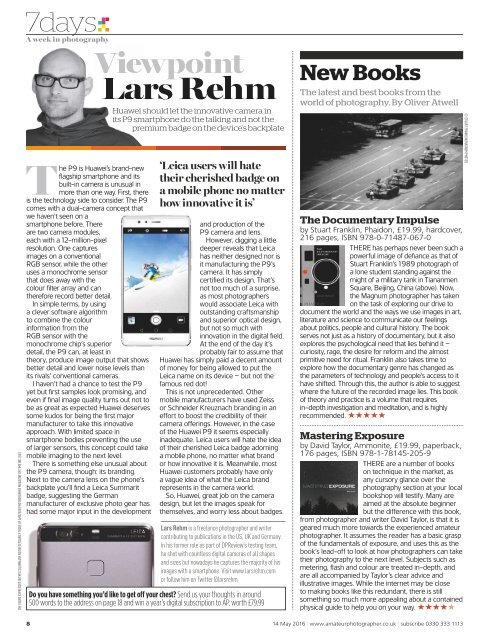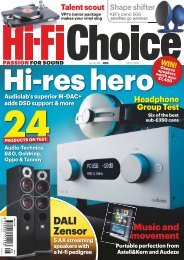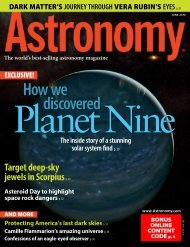Create successful ePaper yourself
Turn your PDF publications into a flip-book with our unique Google optimized e-Paper software.
THE VIEWS EXPRESSED IN THIS COLUMN ARE NOT NECESSARILY THOSE OF AMATEUR PHOTOGRAPHER MAGAZINE OR TIME INC. (UK)<br />
The P9 is Huawei’s brand-new<br />
fl agship smartphone and its<br />
built-in camera is unusual in<br />
more than one way. First, there<br />
is the technology side to consider. The P9<br />
comes with a dual-camera concept that<br />
we haven’t seen on a<br />
smartphone before. There<br />
are two camera modules,<br />
each with a 12-million-pixel<br />
resolution. One captures<br />
images on a conventional<br />
RGB sensor, while the other<br />
uses a monochrome sensor<br />
that does away with the<br />
colour fi lter array and can<br />
therefore record better detail.<br />
In simple terms, by using<br />
a clever software algorithm<br />
to combine the colour<br />
information from the<br />
RGB sensor with the<br />
monochrome chip’s superior<br />
detail, the P9 can, at least in<br />
theory, produce image output that shows<br />
better detail and lower noise levels than<br />
its rivals’ conventional cameras.<br />
I haven’t had a chance to test the P9<br />
yet but fi rst samples look promising, and<br />
even if fi nal image quality turns out not to<br />
be as great as expected Huawei deserves<br />
some kudos for being the fi rst major<br />
manufacturer to take this innovative<br />
approach. With limited space in<br />
smartphone bodies preventing the use<br />
of larger sensors, this concept could take<br />
mobile imaging to the next level.<br />
There is something else unusual about<br />
the P9 camera, though: its branding.<br />
Next to the camera lens on the phone’s<br />
backplate you’ll fi nd a Leica Summarit<br />
badge, suggesting the German<br />
manufacturer of exclusive photo gear has<br />
had some major input in the development<br />
Viewpoint<br />
Lars Rehm<br />
Huawei should let the innovative camera in<br />
its P9 smartphone do the talking and not the<br />
premium badge on the device’s backplate<br />
ÔLeica users will hate<br />
their cherished badge on<br />
a mobile phone no matter<br />
how innovative it isÕ<br />
and production of the<br />
P9 camera and lens.<br />
However, digging a little<br />
deeper reveals that Leica<br />
has neither designed nor is<br />
it manufacturing the P9’s<br />
camera. It has simply<br />
certifi ed its design. That’s<br />
not too much of a surprise,<br />
as most photographers<br />
would associate Leica with<br />
outstanding craftsmanship<br />
and superior optical design,<br />
but not so much with<br />
innovation in the digital fi eld.<br />
At the end of the day it’s<br />
probably fair to assume that<br />
Huawei has simply paid a decent amount<br />
of money for being allowed to put the<br />
Leica name on its device – but not the<br />
famous red dot!<br />
This is not unprecedented. Other<br />
mobile manufacturers have used Zeiss<br />
or Schneider Kreuznach branding in an<br />
effort to boost the credibility of their<br />
camera offerings. However, in the case<br />
of the Huawei P9 it seems especially<br />
inadequate. Leica users will hate the idea<br />
of their cherished Leica badge adorning<br />
a mobile phone, no matter what brand<br />
or how innovative it is. Meanwhile, most<br />
Huawei customers probably have only<br />
a vague idea of what the Leica brand<br />
represents in the camera world.<br />
So, Huawei, great job on the camera<br />
design, but let the images speak for<br />
themselves, and worry less about badges.<br />
Lars Rehm is a freelance photographer and writer<br />
contributing to publications in the US, UK and Germany.<br />
In his former role as part of DPReview’s testing team,<br />
he shot with countless digital cameras of all shapes<br />
and sizes but nowadays he captures the majority of his<br />
images with a smartphone. Visit www.larsrehm.com<br />
or follow him on Twitter @larsrehm<br />
Do you have something you’d like to get off your chest? Send us your thoughts in around<br />
500 words to the address on page 18 and win a year’s digital subscription to AP, worth £79.99<br />
New Books<br />
The latest and best books from the<br />
world of photography. By Oliver Atwell<br />
The Documentary Impulse<br />
by Stuart Franklin, Phaidon, £19.99, hardcover,<br />
216 pages, ISBN 978-0-71487-067-0<br />
THERE has perhaps never been such a<br />
powerful image of defi ance as that of<br />
Stuart Franklin’s 1989 photograph of<br />
a lone student standing against the<br />
might of a military tank in Tiananmen<br />
Square, Beijing, China (above). Now,<br />
the Magnum photographer has taken<br />
on the task of exploring our drive to<br />
document the world and the ways we use images in art,<br />
literature and science to communicate our feelings<br />
about politics, people and cultural history. The book<br />
serves not just as a history of documentary, but it also<br />
explores the psychological need that lies behind it –<br />
curiosity, rage, the desire for reform and the almost<br />
primitive need for ritual. Franklin also takes time to<br />
explore how the documentary genre has changed as<br />
the parameters of technology and people’s access to it<br />
have shifted. Through this, the author is able to suggest<br />
where the future of the recorded image lies. This book<br />
of theory and practice is a volume that requires<br />
in-depth investigation and meditation, and is highly<br />
recommended. ★★★★★<br />
Mastering Exposure<br />
by David Taylor, Ammonite, £19.99, paperback,<br />
176 pages, ISBN 978-1-78145-205-9<br />
THERE are a number of books<br />
on technique in the market, as<br />
any cursory glance over the<br />
photography section at your local<br />
bookshop will testify. Many are<br />
aimed at the absolute beginner<br />
but the difference with this book,<br />
from photographer and writer David Taylor, is that it is<br />
geared much more towards the experienced amateur<br />
photographer. It assumes the reader has a basic grasp<br />
of the fundamentals of exposure, and uses this as the<br />
book’s lead-off to look at how photographers can take<br />
their photography to the next level. Subjects such as<br />
metering, fl ash and colour are treated in-depth, and<br />
are all accompanied by Taylor’s clear advice and<br />
illustrative images. While the internet may be close<br />
to making books like this redundant, there is still<br />
something so much more appealing about a contained<br />
physical guide to help you on your way. ★★★★★<br />
© STUART FRANKLIN/MAGNUM PHOTOS<br />
8 14 May 2016 I www.amateurphotographer.co.uk I subscribe 0330 333 1113






